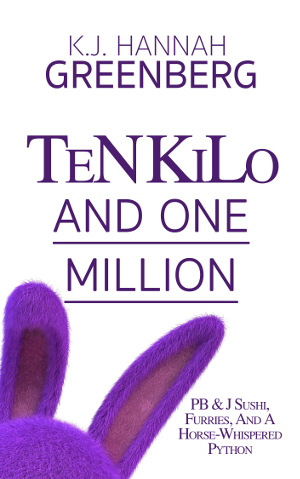KJ Hannah Greenberg
Ten Kilo and One Million
 |
Ten Kilo and One Million
Crooked Cat Books. France.
Aug. 2017. Buy it
here.
We whisper to ourselves that there is no Abominable Snowman. We whimper that we could catch a cold if we’re exposed to viruses, but not if we walk outside with wet hair on winter days. We posit that the richness of our personalities is far more important than our fiduciary standing. Nonetheless, most of us moan when we: suspect moving shadows are watching us fall asleep, sneeze during holiday festivities, or want material goods whose costs outstrip our resources. Fortunately, we’re sometimes called out on this lunacy.
Ten Kilo and One Million is one such challenge to our innate craziness. Although a fanciful tale, this book is also a thoughtful one. In this story of self-discovery, a ceramic artist, who used to be a chemist, strives to become a psychologist. Also: a glass-eyed oncologist tries to make empirical sense out of the qualitative experience that is furrydom, a python nonchalantly sucks down an all-but-retired horse whisperer, a simple barkeep earns a large fortune selling peanut butter and jelly-covered sushi, a thespian, who formerly practiced free love, settles into marriage, a coterie of Junior Leaguers learns to temporarily suspend its efforts at image management, and a rhetoric professor reevaluates the worth of her struggle to maintain career-engined social status.
To confront its readers, Ten Kilo and One Million uses hyperbole. Similarly, this story places ferry captains, anatomically correct marzipan, a dead Trait du Nord, and a cat habituated to farting, in juxtaposition to questions about: the role of reverence in dysfunctional families, the significance of biological clocks, the importance of preserving local ecosystems, the worth of professional accomplishments, and the emotional, psychological and symbolic value of profound riches.
This book’s inclusion of sex, drugs, and rock & roll is not what endears it; plenty of existent narratives feature musicians paying bills by selling pot to authorities or set designers repeatedly losing hold of their bloomers. Rather, Ten Kilo and One Million is special because it invites its readers to think critically about life.
Ten Kilo and One Million asserts that long-term complications can often be resolved through simple tactics. Going to college and graduate school, and then, finally, arriving at a tenured position, for instance, is shown as less desirable than establishing lasting friendships. Heading up a multimillion dollar conglomerate, for example, is portrayed as bringing less happiness than marrying and parenting. Eating countless mice is shown to be sating, but is, as well, shown to be the cause of tummy aches.
Correspondingly, Ten Kilo and One Million can and ought to be read for laughs, yet it also can and ought to be read to call to mind the merit of being accountable. There’s no singular best way to react to life’s tests of our patience and endurance; we “win” only when we’re culpable for our responses. To wit, it’s in our interest to allow this book’s disturbed academic, her gallery of quirky friends, and the strip poker games, oregano brownies, designer duds, and pesticide companies, with which they interact, to ease us into self-exploration.
Acknowledgements
About the Author
Preface
Chapter One: Booty for Beauty
Chapter Two: Whistling in Chicago
Chapter Three: The Smell of Sweat, Radiation, and Dead Trait du Nords
Chapter Four: Omelet-Wrapped Sushi and Baby Anacondas
Chapter Five: A Little Dysfunction
Chapter Six: Dragon Tails and Other Lucky Talismans
Chapter Seven: The Number of Reptiles that Fit into a Single Elevator
Chapter Eight: Fursuiters and Horse Whisperers
Chapter Nine: Carambola, Pregnant Women, and Chicago Weddings
Chapter Ten: Ten Kilo and One Million